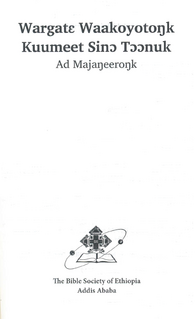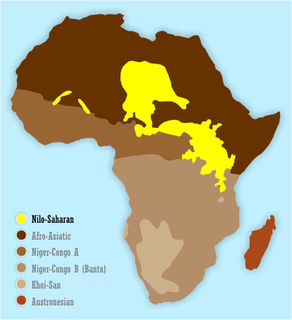Ongota is a moribund language of southwest Ethiopia. UNESCO reported in 2012 that out of a total ethnic population of 115, only 12 elderly native speakers remained, the rest of their small village on the west bank of the Weito River having adopted the Tsamai language instead. The default word order is subject–object–verb. The classification of the language is obscure.
Shabo is an endangered language and likely language isolate spoken by about 400 former hunter-gatherers in southwestern Ethiopia, in the westernmost part of the Southern Nations, Nationalities, and People's Region. They live in three places in the Keficho Shekicho Zone: Anderaccha, Gecha, and Kaabo. As they shift from hunting and gathering to more settled agriculture and to working as laborers, many of its speakers are shifting to other neighboring languages, in particular Majang language and Shekkacho (Mocha); its vocabulary is heavily influenced by loanwords from both these languages, particularly Majangir, as well as Amharic. Its classification is uncertain, though it appears to be a Nilo-Saharan language. It was first reported to be a separate language by Lionel Bender in 1977, based on data gathered by missionary Harvey Hoekstra. A grammar was published in 2015.
The Koman languages are a small close-knit family of languages located along the Sudan–Ethiopia border with about 50,000 speakers. They are commonly believed to belong to the Nilo-Saharan family, but evidence is slight, and among scholars who do accept inclusion, opinions vary as to their position within it.
Berta proper, a.k.a. Gebeto, is spoken by the Berta in Sudan and Ethiopia.

In most classifications, the Eastern Sudanic languages are a group of nine families of languages that may constitute a branch of the Nilo-Saharan language family. Eastern Sudanic languages are spoken from southern Egypt to northern Tanzania.
The Surmic Languages are a branch of the Eastern Sudanic language family.
The languages of Ethiopia refers to the various spoken forms of communication in Ethiopia. It includes the nation's official languages, its national and regional languages, as well as its minority and foreign languages.

The Majang people, or Majangir, live in southwestern Ethiopia and speak a Nilo-Saharan language of the Surmic cluster. The 1998 census gave the total of the Majangir population as 15,341, but since they live scattered in the hills in dispersed settlements, their actual total number is undoubtedly much higher. They live around cities of Tepi, Mett'i, and scattered southwest of Mizan Teferi and towards Gambela.
Marvin Lionel Bender was an American author and linguist.

The Majang language is spoken by the Majangir people of Ethiopia. Although it is a member of the Surmic cluster, this language is the most isolated one in that cluster. A language survey has shown that dialect variation from north to south is minor and does not seriously impede communication. The 2007 Ethiopian Census lists 6,433 speakers for Majang (Messengo), but also reports that the ethnic group consists of 32,822 individuals. According to the census, almost no speakers can be found in Mezhenger Zone of Gambela Region; a total of eleven speakers are listed for the zone, but almost 10,000 ethnic Mejenger or Messengo people.
The South Omotic, Somotic, or Aroid languages belong to the Afro-Asiatic family and are spoken in Ethiopia. There are four languages:
Hozo is an Afroasiatic language spoken mostly in the Kondala woreda of Mirab Welega Zone by peoples generically known as "Mao". There are smaller groups of Hozo speakers in Mana Sibu woreda. The term Hozo is usually understood by the Mao to refer to a clan. Hozo speakers prefer to call themselves Amo. Hozo and Seze are sometimes called Begi Mao. Hozo is spoken by roughly 3,000 people in Ethiopia. Hozo is also a clan in the Begi area. The Hozo language is also known as Begi-Mao and Mao of Begi. Its classification is Afro-Asiatic, Omotic, and Mao. The word Mao is Omotic and means ‘man; people’, occurring as [ma:ɪ] in Seze and as [mɔ:] in Hozo. Mao is frequently used as an ethnic term. There is a kind of Mao identity across language differences in Ethiopia. While it is generally accepted today that Omotic is one of the primary branches of the Afro-Asiatic family, the position of the four languages Hozo, Seze, Ganza and Northern Mao is still being discussed. The Mao languages are the least documented within Omotic, and Omotic itself is the least documented of the Afroasiatic groups.
The Baale language, Baleesi or Baalesi, is an Eastern Sudanic language of Ethiopia and South Sudan, spoken by the Baale or Zilmamo people of Ethiopia, and by the Kachepo of South Sudan. It is a member of the Surmic cluster and is also known as Suri, evoking an ethnonym that embraces the Tirma, Chai, and Baale communities. There are currently 9,000 native speakers of Baleesi, 5,000 in South Sudan and 4,100 in Ethiopia; almost all of these are monolingual.
The Kwegu people are a Surmic ethnic group inhabiting the shores of the Omo River in southwestern Ethiopia.
Kwegu is a Nilo-Saharan Eastern Sudanic language, spoken in the Southwest of Ethiopia, on the west bank of the Omo River.
Murle is a Nilo-Saharan Eastern Sudanic language spoken by the Murle people, spoken in the southeast of South Sudan, near the Ethiopian border. A very small number of Murle live across the border in southwestern Ethiopia.
Suri, is a Nilo-Saharan Eastern Sudanic language, of the Surmic grouping. It is spoken in the Bench Maji Zone of the Southern Nations, Nationalities, and People's Region (SNNPR) in Ethiopia, to the South Sudan border, and across the border in South Sudan by the Suri. The language has over 80% lexical similarity to Mursi. The language is often referred to by another form of its name, Surma, after which the Surmic branch of Eastern Sudanic is named, but that form is frequently used for the three related languages spoken by the Surma people: Suri, Mursi, and Me'en.
The Didinga language (’Di’dinga) is an Eastern Sudanic language spoken by the Chukudum and Lowudo peoples of the Didinga Hills of South Sudan. It is classified as a member of the southwest branch Surmic languages. Its nearest relative is Narim.
Tennet is a Nilo-Saharan, Eastern Sudanic, Surmic language spoken by the Tennet people. The Tennet home area is a group of ten (10) villages at the northern end of the Lopit mountains, 65 kilometers northeast of Torit.




